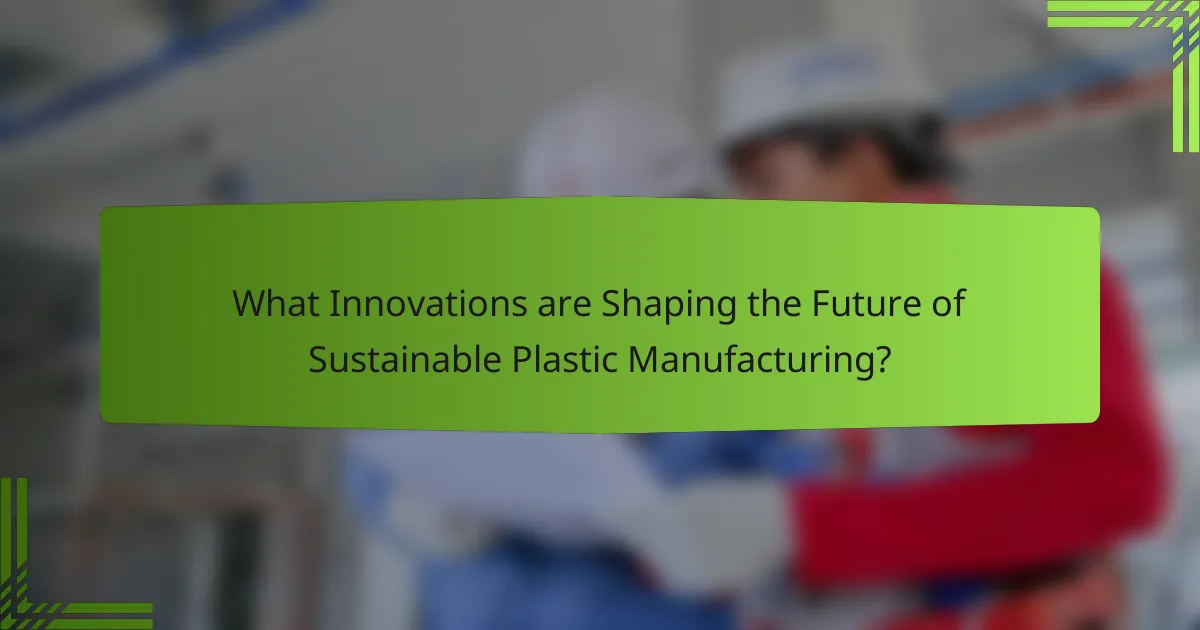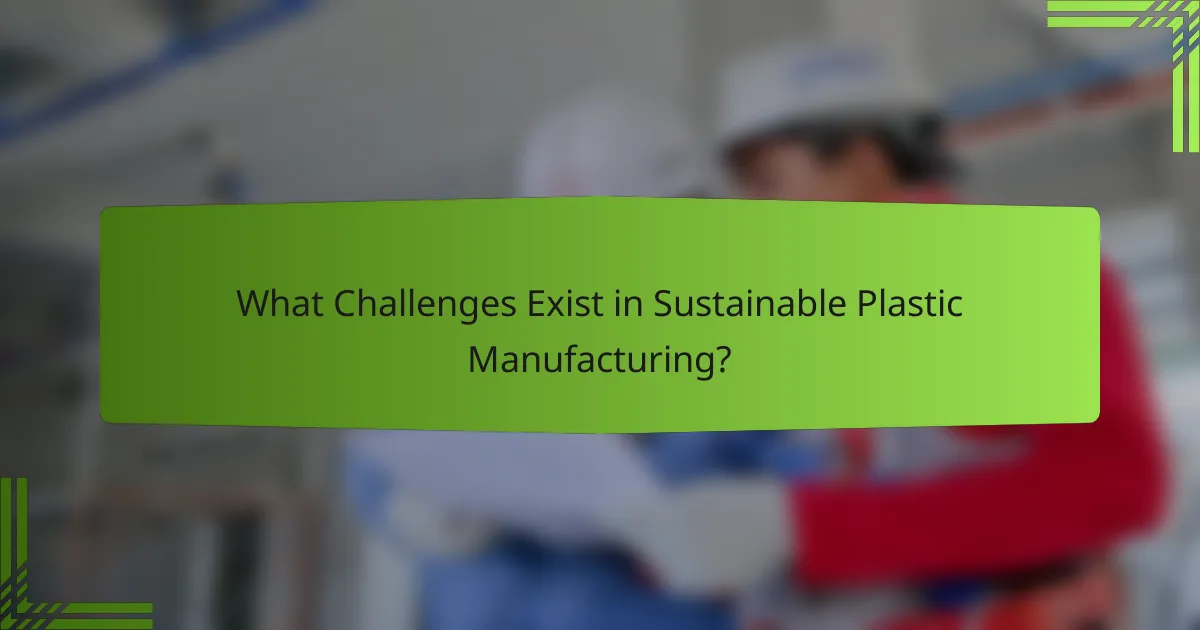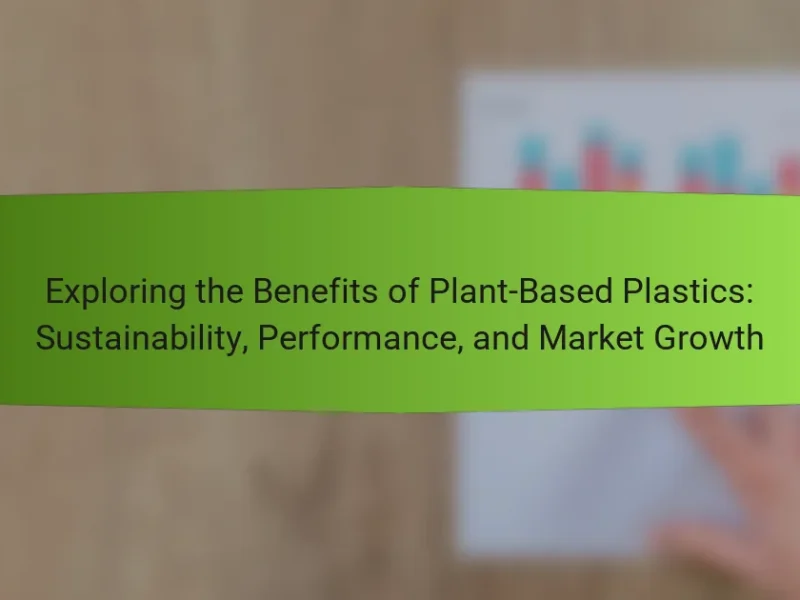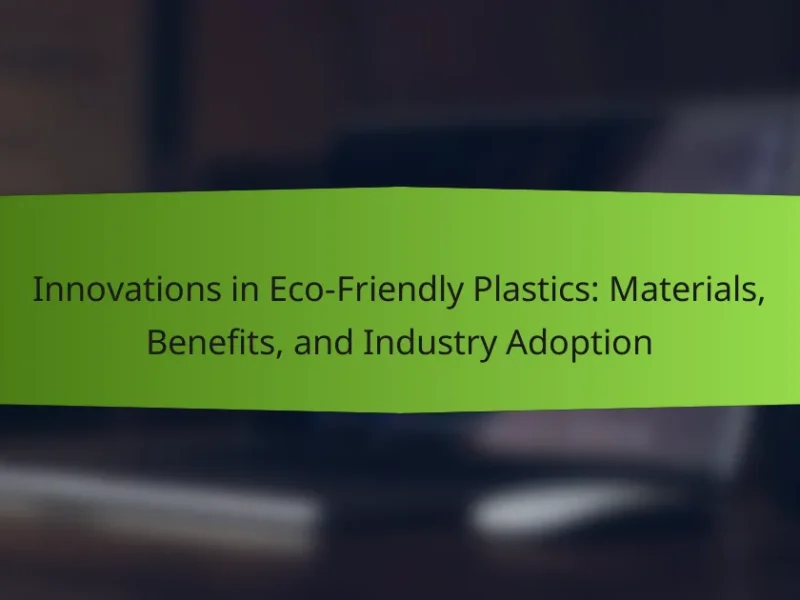Sustainable plastic manufacturing is the production of plastics utilizing environmentally friendly processes and materials to minimize ecological impact throughout their lifecycle. This approach incorporates innovations such as biodegradable plastics, which break down naturally, and the use of recycled materials to enhance efficiency. Key players in this sector include companies like BASF and NatureWorks, known for their bioplastics made from renewable resources. However, sustainable plastic manufacturing faces challenges such as higher costs, limited recycling infrastructure, low consumer demand, and regulatory hurdles. The article will explore these innovations, challenges, and the role of environmental policies in shaping the future of sustainable plastic manufacturing.

What is Sustainable Plastic Manufacturing?
Sustainable plastic manufacturing refers to the production of plastics using environmentally friendly processes and materials. This approach aims to minimize environmental impact throughout the lifecycle of plastic products. Sustainable manufacturing often involves using renewable resources, such as bioplastics derived from plants. It also emphasizes energy efficiency and waste reduction in production processes. According to the Ellen MacArthur Foundation, adopting sustainable practices can significantly reduce plastic pollution. Furthermore, sustainable plastic manufacturing supports circular economy principles by promoting recycling and reusing materials. This method contrasts with traditional plastic manufacturing, which relies heavily on fossil fuels and contributes to pollution.
How does sustainable plastic manufacturing differ from traditional methods?
Sustainable plastic manufacturing differs from traditional methods by prioritizing eco-friendly materials and processes. Traditional methods often rely on fossil fuels for production. In contrast, sustainable practices utilize renewable resources, such as bioplastics made from plant materials. Traditional methods generate significant greenhouse gas emissions. Sustainable manufacturing aims to minimize these emissions through energy-efficient technologies. Traditional plastics often end up in landfills and oceans. Sustainable methods focus on recyclability and biodegradability to reduce environmental impact. Additionally, sustainable practices often involve closed-loop systems that recycle materials back into production. This approach contrasts with the linear model of traditional manufacturing, which typically does not account for end-of-life solutions.
What materials are used in sustainable plastic manufacturing?
Sustainable plastic manufacturing utilizes materials such as bioplastics, recycled plastics, and renewable resources. Bioplastics are derived from natural materials like corn starch or sugarcane. Recycled plastics are sourced from post-consumer waste, reducing the need for new raw materials. Renewable resources provide alternatives to fossil fuels, which are typically used in conventional plastics. Studies show that using these materials can significantly lower carbon emissions. For instance, bioplastics can reduce greenhouse gas emissions by up to 80% compared to traditional plastics.
What processes are involved in sustainable plastic manufacturing?
Sustainable plastic manufacturing involves processes that minimize environmental impact. Key processes include the use of bio-based feedstocks, which reduce reliance on fossil fuels. These feedstocks can originate from renewable resources like corn or sugarcane. Another important process is recycling, which reuses existing plastics to create new products. This reduces waste and conserves resources.
Additionally, energy-efficient manufacturing techniques are essential. These methods lower energy consumption during production. Closed-loop systems also play a role by recapturing waste materials for reuse. Furthermore, the use of biodegradable additives can enhance the environmental profile of plastics. These additives help plastics break down more easily in natural environments.
Together, these processes contribute to a more sustainable approach to plastic manufacturing. They align with global efforts to reduce pollution and promote circular economy principles.
Why is sustainable plastic manufacturing important for the environment?
Sustainable plastic manufacturing is important for the environment because it reduces waste and pollution. Traditional plastic production often results in significant carbon emissions and resource depletion. Sustainable methods utilize renewable resources and minimize harmful byproducts. For instance, bioplastics can be made from plant materials, reducing reliance on fossil fuels. Research indicates that sustainable practices can lower greenhouse gas emissions by up to 50%. Additionally, these practices help decrease the accumulation of plastic waste in oceans and landfills. By promoting recycling and reusability, sustainable plastic manufacturing contributes to a circular economy. This approach ultimately protects ecosystems and promotes biodiversity.
What are the environmental impacts of traditional plastic manufacturing?
Traditional plastic manufacturing has significant environmental impacts. It generates greenhouse gases, contributing to climate change. The production process often releases volatile organic compounds, which can harm air quality. Additionally, plastic manufacturing consumes large amounts of fossil fuels, depleting natural resources. Water pollution is another concern, as chemicals used in production can contaminate local water supplies. According to the United Nations Environment Programme, plastic production and incineration contribute to about 850 million metric tons of greenhouse gases annually. Moreover, plastic waste accumulates in landfills and oceans, harming wildlife and ecosystems. Overall, traditional plastic manufacturing poses serious threats to environmental health.
How does sustainable plastic manufacturing reduce waste?
Sustainable plastic manufacturing reduces waste by utilizing renewable resources and minimizing byproducts. This approach often incorporates bioplastics made from materials like corn starch or sugarcane. These materials are biodegradable, leading to less plastic accumulation in landfills. Additionally, sustainable practices involve recycling existing plastics, which decreases the need for virgin materials. According to the Ellen MacArthur Foundation, transitioning to a circular economy could reduce plastic waste by 30% by 2030. Furthermore, energy-efficient production methods lower overall emissions and waste generated during manufacturing. These strategies collectively contribute to a significant reduction in plastic waste.

What Innovations are Shaping the Future of Sustainable Plastic Manufacturing?
Biodegradable plastics are a key innovation shaping sustainable plastic manufacturing. These materials break down naturally, reducing environmental impact. Companies like BASF and NatureWorks are leading in this sector. They produce polylactic acid (PLA) and polyhydroxyalkanoates (PHA). These bioplastics come from renewable resources like corn starch and sugarcane. Another innovation is the use of recycled plastics in production. Mechanical and chemical recycling processes are improving efficiency. For example, companies like Loop Industries are creating high-quality recycled PET. Additionally, advancements in additive manufacturing are reducing waste. 3D printing technologies enable precise material usage. These innovations collectively aim to minimize plastic pollution and promote sustainability in the industry.
What new technologies are being developed?
New technologies in sustainable plastic manufacturing include biodegradable materials, bioplastics, and advanced recycling methods. Biodegradable materials break down naturally, reducing environmental impact. Bioplastics are derived from renewable resources like corn and sugarcane. Advanced recycling methods, such as chemical recycling, convert plastics back into their original monomers. These innovations aim to decrease plastic waste and reliance on fossil fuels. Research shows that bioplastics can reduce carbon emissions by up to 80% compared to traditional plastics. The development of these technologies is crucial for a sustainable future in plastic manufacturing.
How are bioplastics contributing to sustainability?
Bioplastics contribute to sustainability by reducing reliance on fossil fuels. They are derived from renewable resources, such as corn starch or sugarcane. This shift decreases greenhouse gas emissions compared to conventional plastics. According to a study by the European Bioplastics Association, bioplastics can reduce carbon footprints by up to 50%. Additionally, many bioplastics are biodegradable or compostable. This characteristic helps minimize plastic waste in landfills and oceans. As a result, bioplastics support a circular economy by facilitating resource recovery. Their use promotes sustainable practices in various industries, including packaging and consumer goods.
What role does recycling technology play in innovation?
Recycling technology plays a crucial role in driving innovation within sustainable plastic manufacturing. It enables the transformation of waste materials back into usable resources. This process reduces the demand for virgin materials and minimizes environmental impact. Advanced recycling technologies, such as chemical recycling, allow for the breakdown of plastics into their original monomers. This innovation enhances the quality and versatility of recycled materials. According to a report by the Ellen MacArthur Foundation, effective recycling can significantly lower greenhouse gas emissions. Additionally, it fosters the development of new business models focused on circular economy principles. These innovations create economic opportunities while addressing environmental challenges.
How can companies implement these innovations?
Companies can implement innovations in sustainable plastic manufacturing by adopting advanced technologies and practices. They should invest in research and development to create biodegradable materials. Collaboration with universities and research institutions can enhance innovation. Implementing circular economy principles will promote recycling and reduce waste. Training employees on sustainable practices is crucial for effective implementation. Companies can also engage with stakeholders to align goals and strategies. Regulatory compliance ensures that innovations meet environmental standards. Finally, monitoring and measuring the impact of these innovations will provide valuable insights for continuous improvement.
What are some successful case studies of innovation in sustainable plastic manufacturing?
Successful case studies of innovation in sustainable plastic manufacturing include companies like Biome Bioplastics and BASF. Biome Bioplastics developed a range of biodegradable and compostable bioplastics made from renewable sources. Their products reduce reliance on fossil fuels and minimize environmental impact. BASF introduced the “Ecovio” line, a biodegradable plastic that combines traditional plastics with renewable raw materials. This innovation helps to reduce plastic waste in landfills and oceans. Another example is the partnership between Coca-Cola and the Coca-Cola Foundation. They invested in the development of plant-based PET plastic, aiming for a fully circular economy. These initiatives demonstrate effective strategies in sustainable plastic production.
What challenges do companies face when adopting new technologies?
Companies face several challenges when adopting new technologies. Resistance to change is a primary obstacle. Employees may be reluctant to alter established workflows. This reluctance can hinder the implementation process. Additionally, there are often high costs associated with new technology. These costs include both initial investments and ongoing maintenance. Companies also grapple with a skills gap. Employees may lack the necessary training to utilize new tools effectively. Moreover, integration with existing systems presents a significant challenge. New technologies must work seamlessly with legacy systems to be effective. Finally, companies may encounter regulatory hurdles. Compliance with industry standards can complicate the adoption process.

What Challenges Exist in Sustainable Plastic Manufacturing?
Sustainable plastic manufacturing faces several challenges. One major challenge is the high cost of sustainable materials compared to traditional plastics. For instance, bioplastics often require more expensive raw materials and production processes. Another challenge is the limited availability of recycling infrastructure. Many regions lack facilities to effectively recycle sustainable plastics. Additionally, consumer awareness and demand for sustainable products remain low. This affects market growth and investment in sustainable manufacturing. Technical limitations also pose challenges. Current technology may not efficiently produce biodegradable plastics at scale. Lastly, regulatory hurdles can slow down innovation. Compliance with varying environmental policies can complicate manufacturing processes.
What are the main obstacles to widespread adoption?
The main obstacles to widespread adoption of sustainable plastic manufacturing include high production costs and limited scalability. High production costs arise from the advanced technologies and materials required for sustainable processes. Limited scalability is due to the current infrastructure not supporting large-scale production of sustainable plastics. Additionally, regulatory hurdles can impede the adoption of new manufacturing methods. Market resistance also exists, as consumers may prefer traditional plastics due to lower prices. Furthermore, the lack of awareness about sustainable options contributes to slow adoption rates. These factors collectively hinder the transition to sustainable plastic manufacturing.
How do economic factors influence sustainable plastic manufacturing?
Economic factors significantly influence sustainable plastic manufacturing by affecting production costs and investment in green technologies. Higher raw material costs can deter manufacturers from adopting sustainable practices. Conversely, lower costs for renewable resources encourage the shift towards eco-friendly alternatives. Market demand for sustainable products drives innovation in manufacturing processes. Economic incentives, such as government subsidies and tax breaks, promote investment in sustainable practices. For instance, a 2021 study by the Ellen MacArthur Foundation highlights that economic viability is crucial for scaling up sustainable plastic solutions. Additionally, global economic trends impact supply chains, influencing the availability of sustainable materials. Thus, the interplay of these economic factors shapes the landscape of sustainable plastic manufacturing.
What regulatory challenges do manufacturers face?
Manufacturers face numerous regulatory challenges, particularly in sustainable plastic manufacturing. Compliance with environmental regulations is a significant hurdle. Regulations often require manufacturers to reduce emissions and waste. This can lead to increased operational costs. Additionally, manufacturers must navigate varying regulations across different regions. These discrepancies complicate manufacturing processes and supply chain management. Manufacturers also face challenges in sourcing sustainable materials. Regulations may restrict certain materials deemed harmful to the environment. Ensuring product safety and meeting consumer standards adds another layer of complexity. Overall, regulatory compliance demands significant resources and strategic planning from manufacturers.
How can these challenges be overcome?
Innovations in technology and policy can effectively overcome challenges in sustainable plastic manufacturing. Implementing biodegradable materials reduces reliance on traditional plastics. Advanced recycling techniques can enhance material recovery rates. Investment in research fosters the development of sustainable alternatives. Regulatory frameworks can incentivize eco-friendly practices in production. Collaboration among stakeholders promotes shared solutions and best practices. Education and awareness campaigns can drive consumer demand for sustainable products. These strategies collectively address the environmental impact of plastic manufacturing.
What strategies can companies employ to address these challenges?
Companies can employ several strategies to address challenges in sustainable plastic manufacturing. First, they can invest in research and development for biodegradable alternatives. This approach helps reduce reliance on conventional plastics. Second, companies can implement circular economy practices. This includes recycling and reusing materials to minimize waste. Third, they can collaborate with stakeholders for better supply chain transparency. Such collaboration fosters sustainable sourcing of raw materials. Fourth, adopting eco-friendly manufacturing processes can significantly lower carbon footprints. For instance, using renewable energy sources can enhance sustainability. Fifth, companies can engage in consumer education programs. This raises awareness about sustainable practices and encourages responsible consumption. Finally, compliance with environmental regulations can guide companies in adopting best practices. These strategies collectively contribute to overcoming challenges in sustainable plastic manufacturing.
How important is collaboration among stakeholders in overcoming challenges?
Collaboration among stakeholders is crucial in overcoming challenges. Effective collaboration fosters shared understanding and collective problem-solving. It enables diverse perspectives to address complex issues in sustainable plastic manufacturing. Research indicates that collaborative efforts can lead to innovative solutions and improved resource management. For instance, partnerships among manufacturers, policymakers, and environmental organizations have resulted in successful recycling initiatives. These initiatives demonstrate the power of stakeholder collaboration in achieving sustainability goals. Thus, collaboration is not only important but essential for addressing the multifaceted challenges in the industry.
What Environmental Policies are Impacting Sustainable Plastic Manufacturing?
Environmental policies impacting sustainable plastic manufacturing include regulations aimed at reducing plastic waste and promoting recycling. The European Union’s Single-Use Plastics Directive bans specific single-use plastic items. This directive is designed to minimize plastic pollution in oceans and waterways. Additionally, the Extended Producer Responsibility (EPR) policies require manufacturers to manage the lifecycle of their products. These policies incentivize companies to design recyclable and biodegradable plastics. In the United States, various state-level bans on plastic bags and straws also influence manufacturing practices. The Global Plastics Treaty negotiations aim to establish international standards for plastic production and waste management. These policies collectively drive innovation in sustainable materials and manufacturing processes.
How do government regulations support sustainable practices?
Government regulations support sustainable practices by establishing standards and incentives for environmentally friendly operations. These regulations often mandate reductions in waste and emissions. For example, the Clean Air Act and Clean Water Act set limits on pollutants. Compliance with these laws encourages companies to adopt cleaner technologies. Additionally, regulations may provide tax breaks for sustainable practices. This financial incentive promotes investment in renewable resources. The European Union’s Green Deal exemplifies regulatory frameworks aimed at sustainability. It aims for net-zero greenhouse gas emissions by 2050. Such comprehensive regulations create a structured approach to fostering sustainable practices across industries.
What are the key policies promoting sustainable plastic manufacturing?
Key policies promoting sustainable plastic manufacturing include regulations on plastic production, incentives for recycling, and bans on single-use plastics. Regulations often set limits on the types of materials used in production, encouraging the use of biodegradable alternatives. Incentives for recycling can include tax breaks or grants for companies that invest in sustainable practices. Many regions have implemented bans on single-use plastics to reduce waste. For example, the European Union’s Single-Use Plastics Directive aims to eliminate the top ten single-use plastic items found on beaches. Additionally, extended producer responsibility (EPR) policies require manufacturers to take responsibility for the entire lifecycle of their products. These policies collectively drive innovation and reduce environmental impact in the plastic manufacturing industry.
How do international agreements influence local manufacturing practices?
International agreements significantly influence local manufacturing practices by establishing regulatory standards and trade policies. These agreements often set environmental guidelines that local manufacturers must follow. For example, agreements like the Paris Agreement encourage sustainable practices by limiting greenhouse gas emissions. This pressure leads manufacturers to adopt eco-friendly technologies and materials. Additionally, trade agreements can affect tariffs and import/export regulations, impacting the cost of raw materials. Local manufacturers may need to adjust their supply chains to comply with these agreements. Compliance can drive innovation in manufacturing processes to meet international standards. Overall, international agreements shape local practices towards sustainability and competitiveness in the global market.
What can companies do to align with environmental policies?
Companies can align with environmental policies by implementing sustainable practices. They can reduce waste by adopting circular economy principles. This involves reusing materials and recycling products. Companies should also invest in renewable energy sources. Utilizing solar or wind energy decreases carbon footprints. Additionally, they can enhance energy efficiency in production processes. This can lead to significant reductions in greenhouse gas emissions. Companies should also comply with local and international regulations. This ensures they meet environmental standards. Engaging in transparent reporting practices builds trust with stakeholders. Regular assessments of environmental impact help identify areas for improvement.
What best practices should manufacturers adopt to comply with regulations?
Manufacturers should adopt comprehensive compliance programs to adhere to regulations. These programs must include regular training for employees on regulatory standards. Documentation of all processes and materials is essential for transparency. Manufacturers should conduct periodic audits to assess compliance levels. Engaging with legal experts can help navigate complex regulations. Implementing quality management systems ensures consistent adherence to standards. Staying updated on regulatory changes is crucial for ongoing compliance. Collaborating with industry associations can provide valuable insights and resources.
What are the Future Trends in Sustainable Plastic Manufacturing?
Future trends in sustainable plastic manufacturing include the increased use of bioplastics. Bioplastics are derived from renewable biomass sources. These sources include plants and microorganisms. Another trend is the development of biodegradable plastics. Biodegradable plastics break down more easily in the environment.
Recycling technologies are advancing rapidly. Enhanced recycling methods improve the quality of recycled plastics. These methods also expand the range of materials that can be recycled. Closed-loop recycling systems are gaining traction. They allow manufacturers to reuse plastic waste in new products.
Circular economy principles are being adopted widely. This approach emphasizes reducing waste and maximizing resource use. Companies are also focusing on eco-design. Eco-design integrates environmental considerations into product development.
Government regulations are becoming stricter. Policies are promoting sustainable practices in plastic production. Consumer demand for sustainable products is rising. This trend influences manufacturers to adopt greener practices.
These trends indicate a shift towards more sustainable practices in the plastic industry. The aim is to minimize environmental impact while meeting market needs.
How is consumer demand shaping the future of sustainable plastics?
Consumer demand is significantly shaping the future of sustainable plastics. As consumers increasingly prioritize eco-friendly products, manufacturers are compelled to innovate. This shift is evident in the growing market for bioplastics and recycled materials. According to a report by Smithers, the global bioplastics market is expected to reach $27 billion by 2025. Additionally, brands are responding by setting sustainability goals. For example, major companies like Unilever have committed to using 100% recyclable or reusable plastic by 2025. This consumer-driven pressure is fostering investment in sustainable technologies. Consequently, companies are exploring alternative materials and improving recycling processes. Overall, consumer demand is a key driver in advancing sustainable plastic solutions.
What role will innovation play in the next decade?
Innovation will be crucial in shaping sustainable plastic manufacturing over the next decade. It will drive the development of new materials that are biodegradable and environmentally friendly. Innovations in recycling technologies will enhance the efficiency of plastic waste management. Research indicates that improved processes can increase recycling rates by up to 50%. Advancements in manufacturing techniques will reduce energy consumption and carbon emissions. For instance, bio-based plastics are projected to grow significantly, with a market increase of 20% annually. Moreover, innovation will enable companies to meet stricter environmental regulations effectively. This will lead to a more sustainable industry that balances economic growth with ecological responsibility.
What Practical Steps can Companies Take to Embrace Sustainable Plastic Manufacturing?
Companies can embrace sustainable plastic manufacturing by adopting several practical steps. First, they should invest in biodegradable materials. Research indicates that biodegradable plastics reduce environmental impact significantly. Second, companies can implement recycling programs. Recycling can decrease the demand for virgin plastic by up to 30%, as per industry studies. Third, utilizing renewable energy sources in production is essential. This transition can lower carbon emissions by 50% or more. Fourth, companies should optimize their supply chains for sustainability. Streamlined supply chains can reduce waste and improve efficiency. Fifth, investing in innovative technologies is crucial. Technologies like 3D printing can minimize material waste. Lastly, engaging in partnerships for sustainability initiatives can amplify efforts. Collaborations with environmental organizations can enhance credibility and effectiveness.
How can businesses assess their current practices for sustainability?
Businesses can assess their current practices for sustainability by conducting a comprehensive sustainability audit. This audit involves evaluating resource consumption, waste generation, and emissions. Companies should analyze their supply chain for environmental impact. Engaging stakeholders can provide insights into sustainability performance. Benchmarking against industry standards can identify areas for improvement. Utilizing sustainability reporting frameworks, such as GRI or SASB, can enhance transparency. Data collection on energy use and material efficiency is crucial. Regular assessments help track progress over time and inform strategic decisions.
What resources are available for companies looking to transition to sustainable methods?
Companies looking to transition to sustainable methods can access various resources. These include government grants and incentives designed to support sustainable practices. Organizations like the Environmental Protection Agency (EPA) offer guidance on sustainability initiatives. Industry associations provide best practices and case studies for successful transitions. Non-profit organizations often share research and tools for sustainable development. Universities and research institutions may offer collaboration opportunities for innovation in sustainability. Online platforms also provide courses and certifications on sustainable practices. These resources help companies implement effective sustainability strategies.
The main entity of the article is sustainable plastic manufacturing, which focuses on eco-friendly processes and materials to reduce environmental impact. The article outlines key innovations, such as bioplastics and advanced recycling technologies, while discussing the challenges faced by the industry, including high production costs and limited recycling infrastructure. It also highlights the influence of environmental policies and consumer demand on sustainable practices, emphasizing the importance of collaboration among stakeholders. Overall, the article provides a comprehensive overview of the future trends and practical steps companies can take to embrace sustainability in plastic manufacturing.


